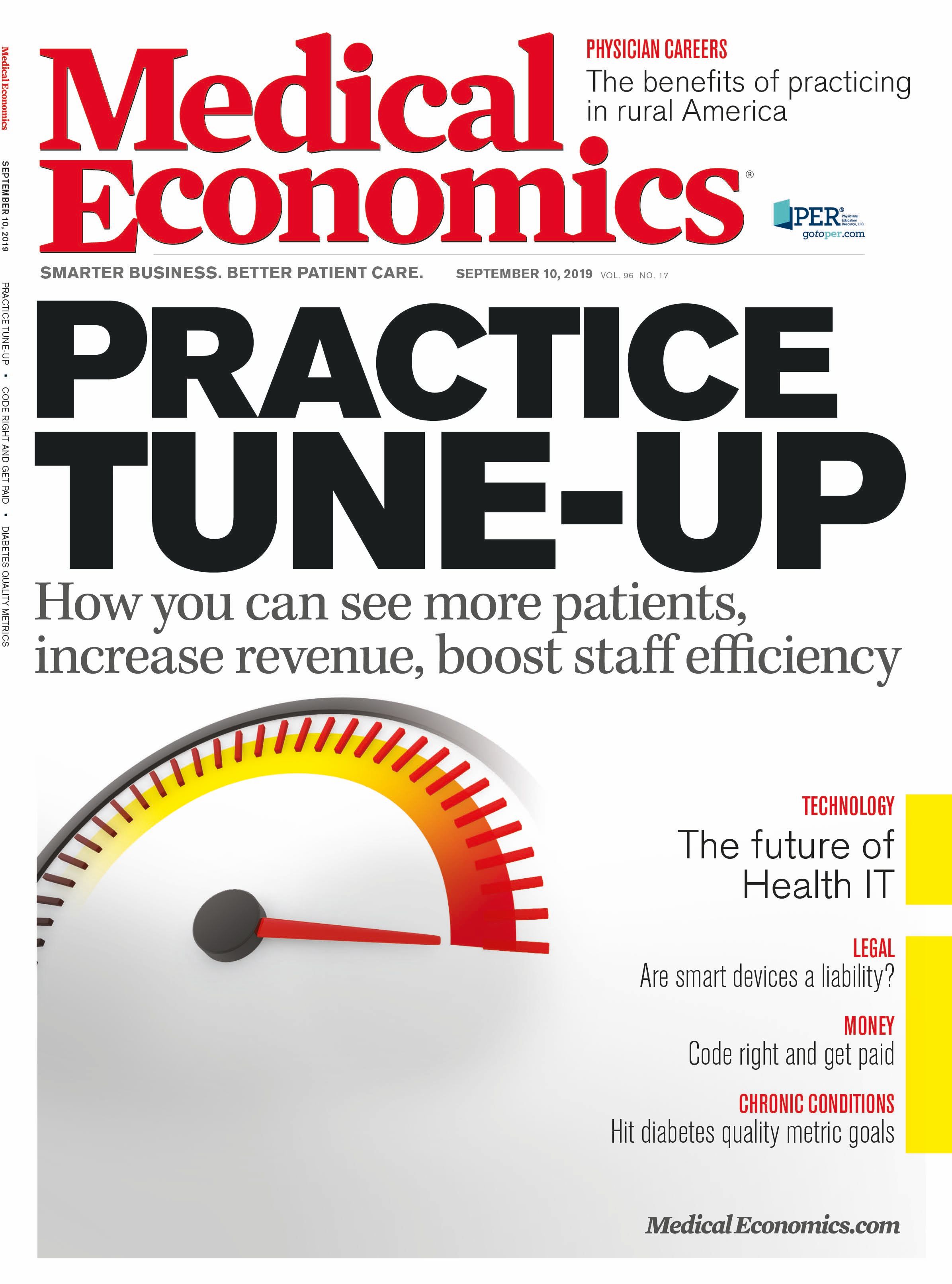Publication
Article
Medical Economics Journal
Coding for revenue
Author(s):
Focus on accurate billing to drive and retain revenue.

Physicians work hard to generate revenue, and with slim operating margins, they don’t want to contend with costly recoupments. Compliant coding and billing helps them avoid the focus of a pre- or post-payment audit.
This article discusses four services that physicians say pose payment challenges along with general tips for coding compliance.
Annual wellness visits vs. physicals: Know Medicare requirements
It’s easy to confuse the AWV and Initial Preventive Physical Exam (IPPE) because both are Medicare-covered services for preventive health. However, there are some notable differences, says Sonal Patel, CPMA, CPC, a coding and compliance consultant with Nexsen Pruet LLC, a business law firm in Charleston, S.C. Patel provides these tips for compliant billing:
1. Know what’s included in the AWV visit vs. the IPPE. Visit the CMS website to learn more about specific requirements for the AWV (including subsequent AWV visits) and IPPE. Documentation should reflect each of these services, says Patel.
2. Report the IPPE, otherwise known as the ‘Welcome to Medicare exam,’ only
once within 12 months of Part B enrollment. The patient is ineligible for this service after 12 months post-enrollment, says Patel.
3. Once the 12 months post-enrollment have elapsed, physicians can bill an AWV once every 11 months thereafter for the patient’s annual AWV. The physician must perform and document all components of the AWV or IPPE, including any updates since the last visit. However, they can’t bill an AWV and IPPE during the same 12 months, says Patel. If the patient needs to be seen after the IPPE but before they’re eligible for the AWV, the physician must bill another appropriate service for which the patient may owe a co-pay or deductible. With the AWV and IPPE, the beneficiary owes nothing.
Telemedicine: Know your codes and modifiers
Telemedicine increases access, convenience and patient satisfaction, but it can cause headaches in terms of getting paid, says Jamie Claypool, CPC, CPMA, practice management consultant at J. Claypool Associates Inc. in Spicewood, Tex. Follow these four tips to avoid denials:
1. Know what codes are acceptable to report as telemedicine. CMS provides a complete list of eligible CPT/HCPCS codes for calendar year 2019 (see pp. 6-9). For example, via telemedicine, physicians can report:
- office visits
- smoking cessation services
- annual depression screenings
- transitional care management
- advance care planning
- prolonged services
- annual wellness visits, and more.
Payment for services rendered via telemedicine is no different from those rendered in the office setting, says Claypool. She adds that commercial payers may or may not allow physicians to report these same services via telemedicine.
2. Report place of service (POS) code 02. POS 02 indicates the physician furnished the service as a professional telehealth service from a distant site. Physicians should not report POS 11 (office) when billing these services, says Joette Derricks, healthcare compliance and revenue integrity consultant in Baltimore.
3. Apply modifier -95, when applicable. This modifier indicates the physician rendered telemedicine services through a synchronous interactive communication, and some commercial payers may require it for certain codes, says Claypool.
4. Don’t confuse telemedicine with virtual check-ins (G2012) and remote evaluations (G2010). Physicians can bill virtual check-ins when they have a direct conversation in real-time with an established patient to determine whether the patient must come into the office to be evaluated. The only caveat is that it’s not billable when the check-in originates from a related E/M service provided within the previous seven days or leads to an E/M service or procedure within the next 24 hours or soonest available appointment. The same caveat is true for remote evaluations during which a physician asynchronously communicates with an established patient (e.g., through the portal) and then speaks with the patient in real time to devise a treatment plan.
CMS doesn’t classify either of these services as telemedicine, which means there are no geographic restrictions, says Derricks. With telemedicine, Medicare will only pay for services when the beneficiary receives the services in an authorized originating site that’s located in a rural Health Professional Shortage Area or a county outside a Metropolitan Statistical Area, she adds. Note that commercial payers don’t accept G2010 and G2012.
Chronic care management (CCM): Avoid common denials
Even though physicians have been able to bill CCM since 2015, they still run in to problems in terms of getting paid, says Kim Garner Huey, CPC, owner of KGG Coding and Reimbursement Consulting in Birmingham, Ala. Here are some common reasons for denials and how to avoid them:
Reason for denial: Multiple providers bill CCM for the same patient during the same 30 days.
How to avoid it: Communicate with specialists regarding who will bill for the CCM. “This code was really intended for primary care, but it’s not restricted to primary care,” says Huey.
Reason for denial: Physician bills CCM more than once every 30 days.
How to avoid it: Set up an alert in the practice management system that prevents physicians from reporting CCM before 30 days have elapsed, says Huey.
Reason for denial: Insufficient documentation.
How to avoid it: This is a problem that tends to surface during post-payment audits, says Huey. Avoid recoupments by ensuring documentation reflects the intent of the code-that is, to manage all of the patient’s chronic conditions. “CMS intended a very personalized, hands-on type of medical management,” she adds. Documentation such as ‘Patient is taking medications as prescribed’ is not sufficient. Instead, she says to document the following:
- List of all of the patient’s conditions with as much specificity as possible
- Why these conditions place the patient at significant risk of death, acute exacerbation/ decompensation, or functional decline
- Comprehensive care plan-What the physician is doing to manage the diagnoses. If a specialist is managing a condition, the primary care physician should note the specialist’s name, the date of the last appointment, and a brief summary of the visit.
For more information about CCM, including patient and practitioner eligibility and the service elements included in the code, visit the CMS web site.
Transitional care management (TCM): Track patients, comply with requirements
Physicians can generate revenue by providing TCM, but they must also be prepared to deal with potential denials, says Huey. Here are some common denials and how to avoid them:
Reason for denial: Commercial payer rejects the code.
How to avoid it: Bill as an office visit instead, since most commercial payers don’t pay for TCM, says Huey.
Reason for denial: Interactive contact (telephone, email, or face to face) with the patient did not take place within two business days of discharge.
How to avoid it: With the rise of hospitalists, very few primary care physicians see their own patients in the hospital, making it difficult to track admissions and discharges, says Huey. She says physicians should tell their patients to notify the practice of any hospitalizations as soon as they occur so the physician can help coordinate care. Then appoint someone in the practice (e.g., a medical assistant or care coordinator) to track the date of discharge and call or email the patient within two business days thereafter.
Even when staff call or email within two business days of discharge, they don’t always document it in the medical record, says Claypool. Best practice is to document the date of discharge, the date of the call, and a very brief summary of the interaction, she adds. If two or more attempts to reach the patient within two business days of discharge are unsuccessful, physicians can bill TCM as long as they meet all of the other requirements. However, staff must document their attempts to reach the patient even after the second business day following discharge and should continue trying until they are successful.
Reason for denial: Documentation doesn’t support high-complexity TCM.
How to avoid it: To report 99496, physicians must perform high-complexity medical decision-making, meaning they must review and document:
- An extensive list of possible diagnoses and/or management options,
- An extensive amount of complex data; and
- High risk of significant complications, morbidity, and/or mortality
Physicians may feel as though they’ve rendered complex TCM because they spent a lot of time talking with a patient, for example, but if the documentation doesn’t reflect the elements listed above, it doesn’t meet the criteria for the code, says Claypool.
For more information about TCM, including TCM components and other resources, visit the CMS Web site.
On the horizon: 3 reimbursement trends to monitor
1. Surprise billing protections.
Twenty-five states have some form of surprise billing protection that prevents physicians from charging patients their out-of-network rates when they go to an in-network hospital or emergency department. President Trump has also vowed to end surprise billing and create more transparency with medical bills. Physicians should keep an eye on this legislation because it could mean they’d take a financial hit for seeing certain patients in the hospital setting, says Tammy Tipton, owner of Appeal Solutions Inc. in Oklahoma City, Okla.
2. Reference-based pricing.
Some commercial payers are moving away from reasonable and customary rates in favor of paying physicians a multiple of the Medicare rate (usually one or two times that rate). However, Medicare often reimburses at cost, leaving a slim profit margin for physicians. Physicians should review their payer contracts, and may need to make some tough decisions (i.e., part ways with some payers), says Tipton.
3. Social determinants of health.
The ICD-10-CM Coordination and Maintenance Committee has proposed approximately 20 new diagnosis codes that address problems related to education and literacy, employment status, housing and economic circumstances and social environment. Physicians should monitor journals and professional association newsletters to see whether these codes are finalized, says David Vence, MA, RHIA, CPC, assistant vice president of coding and compliance at First Class Solutions Inc. in Maryland Heights, Missouri. The new codes are part of the calendar year 2020 Hospital Inpatient Prospective Payment System Final Rule and would take effect October 1.






